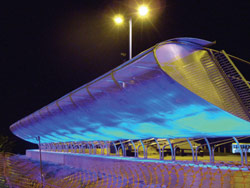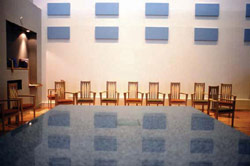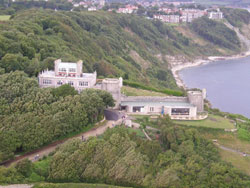PASW Regional Newsletter: Spring 2005
Focus On Current Projects & Issues
Daycaster
A new city gateway structure called Daycaster, designed by Sutherland Hussey Architects and managed by Tom Littlewood of Ginkgo Projects, can be seen adjacent to the Honiton Road interchange next to Devon County Council's Record Office.
Exeter City Council commissioned the work as part of the improvements to the Honiton Road approach to the city.

Daycaster by Sutherland Hussey Architects.
Photo: Richard Horley.
Daycaster is a dynamic structure and articulates through the use of light changing climatic conditions contrasting live weather data against historical weather data.
A solid-state computer, through a linkage to a website, gathers live temperature readings; these readings are then contrasted against the average weather conditions for the time of year. The resulting difference between the actual weather conditions and past average conditions is recorded in differing intensities of coloured light.
The colour of the Daycaster varies from blue to magenta depending on the data sent to the lighting units. White light is produced when the weather conditions are similar to the average conditions. When it is colder, the colour moves towards the blue spectrum, and when warmer, towards the magenta spectrum. As a result of changing weather conditions, the Daycaster shows a slow but dynamic change.
The project has been achieved through the close collaboration between Exeter City Council, the Met Office and Devon County Council. It has only been through each partner trusting the commissioning process and allowing the designers and project manager to take a risk in evolving and applying new technology that the work has taken its final form, which is remarkably close to the original concept design.
Daycaster was mainly funded by the South West Regional Development Agency with support also from Exeter City Council and Devon County Council.
Tom Littlewood, Ginkgo Projects
Creating: excellence
How might artists be involved in regeneration? By producing a piece of public art? Perhaps, but in reality this is only one of many possibilities. Creating:excellence recognises the importance of artists in the creative process and wants to encourage their involvement in regeneration activity. We are also asking artists to look critically at their skills, work and involvement with their community. By looking at both sides of the equation we hope to make regeneration work across the South West even better.
We would like artists to think about how performance art, plays, design, and the creative process itself could be used to improve regeneration. We need artists to use their highly developed creative skills to help us lesser mortals be more creative, to inspire us and to challenge us.
Creating:excellence: the words state our purpose and the importance of creativity. For us to succeed we need artists to get involved. We are setting up a design review panel for the South West and we need artist representation on this important body. The panel will be paid to review the design of key development projects across the region.
If you are interested in getting involved please e-mail Alice at [email protected].
decibel Legacy
decibel was an Arts Council England national initiative established in May 2003 to raise the profile and strength of infrastructure for culturally diverse arts in England.
The decibel project came to an end in March 2004 but, in the South West, we are committed to sustaining the positive dialogues we have established with Diaspora arts and artists across the region.
As part of the regional decibel Legacy project we are implementing a number of projects and activities, and are in the process of establishing a Cultural Diversity Action Planning Group through which we will be asking artists, curators and organisations, working in various artistic communities, to help us make decisions about the future of culturally diverse arts in the South West.
One initiative that has already been implemented as part of the decibel legacy is the Creative Advisors Scheme. This programme aims to support the professional development of artists from Black, Asian and Minority Ethnic (BAME) backgrounds by providing opportunities to work with our Creative Advisors, a bank of established professionals from across the arts sector, and offering small development bursaries of up to £500. We currently have over 25 practitioners working with 8 advisors. If you would like more details about this scheme and how you can become involved, either as an artist or as an advisor, then please contact Samina Zahir, Creative Advisor Manager at [email protected].
From early 2005 we will be looking to develop a new initiative with the working title Go&See. This scheme aims to provide opportunities for contact and dialogue between artists from a diversity of backgrounds, both in terms of their artistic practice and heritage. Over coming weeks we will be inviting artists from across the region to tell us about events they would like to attend and the significance of those events to their artistic development. Through this process we hope to identify 6ñ8 artists who will be invited to attend one event and take part in a facilitated critical discussion as part of a pilot project for the scheme. If you would be interested in being involved please contact Simon Zimmerman at [email protected].
If you would like to remain updated on decibel Legacy projects and activities please register for the Arts Council England, South West's Newsletter. You can register by contacting our Information team on 01392 229222 or email [email protected].
The Devon Quality Design Initiative
After ten years of partnership working, the authorities within the Devon Public Art Consortium (Devon County Council, Teignbridge District Council, East Devon District Council and West Devon Borough Council) have undertaken a review of the way they operate.
As a result of this review, undertaken with an independent consultant and with the support of Public Art South West (PASW), the Consortium has relaunched as the Devon Quality Design Initiative (DQDI). A key element of its work is to ensure that the artist is integrated within the planning and delivery of high quality design, through multi-disciplinary working.
The DQDI will take a countywide approach to high quality design and wishes to broaden the membership and scope of its work in order to provide advocacy, discussion, debate and advice on issues of public art and design.
Key officers of the Devon Unitary, County, District, City and Borough Councils were invited by the Devon Public Art Consortium to a working meeting in November 2004, which was facilitated by Mark Pearson, the Devon and Cornwall Design Action Programme Manager. The purpose of the meeting was to explore the potential for improved quality and design in the built and natural environment and to establish the feasibility and contribution of partnership working, and therefore take advantage of national interest and support for this area of activity through the Commission for Architecture and the Built Environment (CABE) and the Office of the Deputy Prime Minister (ODPM).
This approach is especially pertinent to Local Authorities through their key planning role, but the DQDI will also maintain a good knowledge of and links with multi-disciplinary agencies both regional and countywide, such as SWRDA, the architectural profession, health and housing bodies, the commercial and tourism sector, the Environment Agency and others who are investing in the physical environment of Devon.
At a time of national changes within the planning system, the DQDI feels that it is important to capitalise upon and engage with the current debate around encouraging and improving design quality in development, regeneration and maintenance of the built and natural environment.
Following a useful and well attended first working meeting, Devon local authority representatives met again in the New Year to discuss a joint approach to Local Development Frameworks, and to nominate officers to work on an action plan for the new DQDI.
For more information contact Alan Stone, Urban Designer at Devon County Council.
Tel: 01392 382252.
Update written by Diana Hatton, Public Art Officer, Public Art South West.
Working with Artists
In June 2004 an exciting new scheme was launched aimed at supporting artists to work within or comment on the design, planning and construction sectors in order to influence and create a shared vision for architecture, public space, planning and high quality urban design. Some may say, 'nothing new in that' as public art has been around for years; in the high street, on coastal paths, outside new commercial developments, in the transport system, the local hospital. The list goes on and on.
However, the enthusiasm for including public art ñ or applying a percent for art policy (when a percentage of the capital costs are allocated for the inclusion of artists) has also, ironically, brought its own problems. Public art is sometimes viewed as just another item on the tick list of outputs, possibly only included in the first place for political expediency, or because it's a condition of funding. It can become simply a commodity, identified by the spot marked 'X' on the architect's drawings, with the end result appearing as formulaic as the design it was meant to be imbuing with a ësense of place'. Creative thinking and application, in terms of process, and the realisation of the work is sacrificed in order to meet deadlines. In short, the artist's contribution is considered far too late in the process.
Which is why the new grants scheme PROJECT ñ engaging artists in the built environment, is an important addition to the arts funding mix. Firstly it is funded by the Commission for Architecture and the Built Environment (CABE) and Arts & Business (A&B), two highly influential national organisations. The partnership between the two is a new and welcome development on both sides, and the desire to collaborate with a public art development agency, Public Art South West (PASW), provides an exciting new model of working. Secondly, the intention behind the scheme is to involve artists at the earliest possible stage of development. Either by getting involved in master plans, urban design frameworks and designs for new housing settlements or by working creatively with communities on issues of change and acting as a commentator or provocateur through encouraging a critical discourse in relation to regeneration, its impact and our expectations.
PASW has a history of championing multidisciplinary working and of advocating the importance of the arts, building and design professions recognising the mutual benefits this can bring in terms of delivering high quality environments. The integration of artists' creativity and skills into our built and natural environment can create positive outcomes for communities, urban and rural renaissance and business. When the arts become a recognised component of regeneration they can encourage personal development, build confidence, skills and social networks and encourage social cohesion and community empowerment. Quality of thought and implementation in design result in imaginative and exciting places that are fit for purpose, reflect local identity, provide economic benefits and which meet respective communities' needs by engaging them in the cultural process.
In the early days of public art in this country, the emphasis tended to be on artists' contributions being 'visible'. Sculptures, water features, murals and bins, benches and bollards were the staple public art fare in many cities, towns and villages. The practice of bringing in artists to try and rectify the poor image of unused and unloved spaces, or to ëcheer up' or decorate poorly designed developments were not as rare as one would have liked. Often left to fend for themselves, artists were frequently excluded from the rest of the design team, and certainly had no involvement in the early conceptual thinking. Yet, despite this, they were still expected to turn around disengaged communities with a few workshops and a piece of sculpture. This is not a constructive way to work with anyone and many artists felt seriously compromised by poorly thought out projects, the limitations of the brief and more worryingly, the limited expectations of what they, as creative practitioners, could bring to the process.

The Sanctuary, The Royal Infirmary of Edinburgh, 2004.
Artist: Donald Urquhart. Project Manager: Ginkgo Projects.
Photo: Ruth Clark.
However, practice has moved on and now current thinking advocates for the artist to become part of a multidisciplinary team, fully involved from the outset and with the value placed on their role of creative thinkers, as much as any work that may be an outcome of the collaboration. Yet, whilst many acknowledge that this is the way to work and that the overall quality of design will benefit, they can still find it difficult to fund the research and development phase of a project.
Therefore PROJECT was devised in order to assist the 'early days' of developing regeneration and built and rural environment projects. Focussing primarily, but not exclusively, on the housing, education and healthcare sectors, it provides funds to enable the artist to 'join the team'. In return, the commissioner is expected to be as creative and innovative as possible with regard to the scope and role of the artist. The commissioner is also expected to have frameworks in place which will ensure that the artist's contribution can be fully realised and implemented.
It is still early days for PROJECT, and the first round of awards, one of four rounds up until March 2006, has only just taken place. However, it is already evident from the sheer breadth, imagination and number of applications received, that many around the UK welcome this scheme and have used it to advocate for a different way of working. Ten awards have been made and artists around the country will have opportunities to be involved in a variety of inspiring and groundbreaking projects which range from working with design teams on new schools, the regeneration of town centres, new arterial road routes, re-thinking the way in which large-scale tips and excavations affect our environment and housing and community regeneration projects.
Another key objective of the scheme is to raise the level of current debate about the benefit these schemes have and evaluate whether they will bring about sustainable changes to existing working practices. Therefore, an independent evaluation team, Comedia, has been appointed to research the ways in which artists contribute to public realm design projects and the relative effectiveness of each method, the impact of artist input on the design quality, the regenerative effect, community viability and commercial effectiveness of projects, and the effects in the longer term of this collaborative experience on the practice of artists and design professionals. The resulting report should contain evidence and conclusions which are relevant to the health, education, housing, community regeneration, development, commercial, private, design, planning and arts sectors. The first early findings will be published on the PROJECT website next March.
There is currently a positive political climate in which to promote and push for more creative solutions as to how we develop our environment. It is now legitimate and even expected to take into account what we all instinctively know anyway ñ that creativity matters and brings relevance and quality to our lives. We need to be creative risk-takers prepared to embrace the inspirational and unexpected input of artists in order to extend and enhance our own areas of practice.
Maggie Bolt, Director, Public Art South West
For more information on PASW visit www.publicartonline.org.uk. For more information on PROJECT visit www.project-awards.org.uk
This article was first published in Vista 17/12/04
Durlston Castle, Swanage, Dorset
Thanks to funding from ACESW, support from PASW and teamwork at Dorset County Council the South West based artist, Lulu Quinn, has been appointed to work on concept design as an integral part of the Design Team in the redevelopment and eventual complete renovation of Durlston Castle and its grounds.

Durlston Castle and Country Park, Swanage, Dorset.
Photo: Roy Eggleston.
Dorset County Council has designated Durlston Castle as its potential gateway interpretation centre for the Jurassic Coast World Heritage. The partners - SWRDA, The World Heritage Coastal Team and Dorset County Council - want to ensure that there is a high quality of design throughout the project and therefore recognise the importance of artists who have a creative and innovative input into concept design.
This notion was reflected in the decision to bring the artist on board right at the beginning of the project. The importance that the authority attached to this was also reflected in the selection criteria for the architects, who had to demonstrate that they have worked successfully with an artist on previous projects. Lulu Quinn was on the interview panel that appointed the architects, Long and Kentish. This is an important project for the arts in the South West and indeed nationally, as rather than invite the artist to be involved as an ìadd-onî, the artist will be in the forefront of the process.
Cleo Evans, Visual Arts Development Officer, Dorset County Council [email protected]
